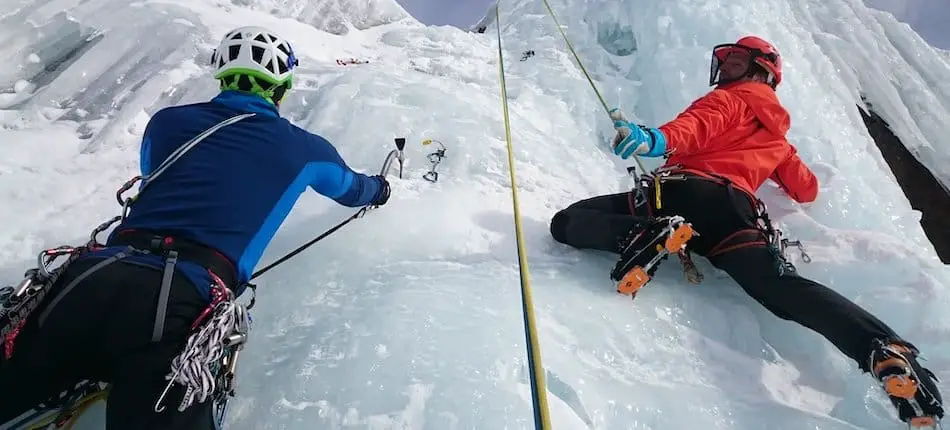
When ice climbing, you need to make sure you have the right footwear. There’s not a lot on this subject online, so I wrote the following article to provide some information.
So, what boots do you wear ice climbing? When ice climbing, you need mountaineering boots. Hiking boots or regular winter boots will not do.
When ice climbing, you use devices called crampons (which are sharpened steel spikes attached to your foot) to help you gain traction. These crampons must be able to integrate with your boot is a secure way so that the two pieces of equipment move as one unit. To achieve this, mountaineering boots have grooves in the rubber soles that the crampon straps to fit into, which allows the crampons to remain in place. Other types of boots, such as hiking boots or ski boots, don’t have these rubber grooves and therefor will not be fit for climbing.
Mountaineering Boots for Ice Climbing
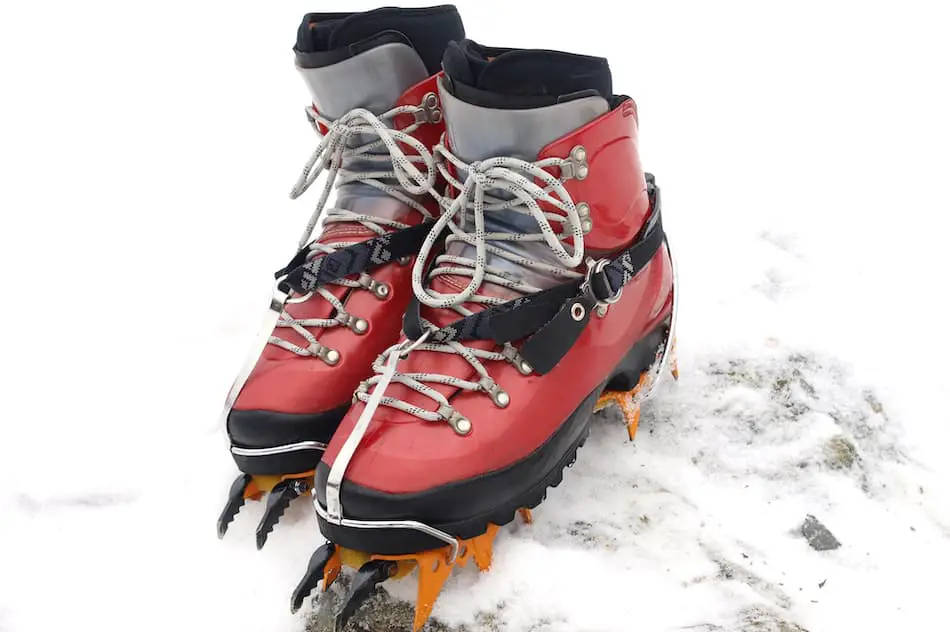
Mountaineering boots are full-ankle boots made out of leather, plastic, or synthetic material that provide a stiff fit and lots of support. The boots often feature a full steel or carbon-fibre shank in the sole, which makes them rigid and inflexible.
As I mentioned above, mountaineering boots have specifically designed grooves in the soles that allow the crampons to clip into place. This gives an ice climber the ability to kick with their crampon and gain traction in the ice, an essential skill to have.
However, that’s not the only feature about mountaineering boots that makes them ideal for ice climbing. There are two other features that make them essential:
Warmth
To go ice climbing, the temperatures need to be at or around 0 degrees Celsius (32 Fahrenheit). Spending an entire day out in these conditions, especially if a significant amount of that time is spent standing around and belaying, can make your feet very cold.
Ice climbing boots are designed to combat against this. They have thermal lining that helps keep the warmth rapped inside the boot. They are also designed to accommodate multiple pairs of socks, so you can layer up on especially cold days. Finally, many pairs of boots come with an additional lining that can be placed outside to further retain heat.
Stiff Soles and Ankles
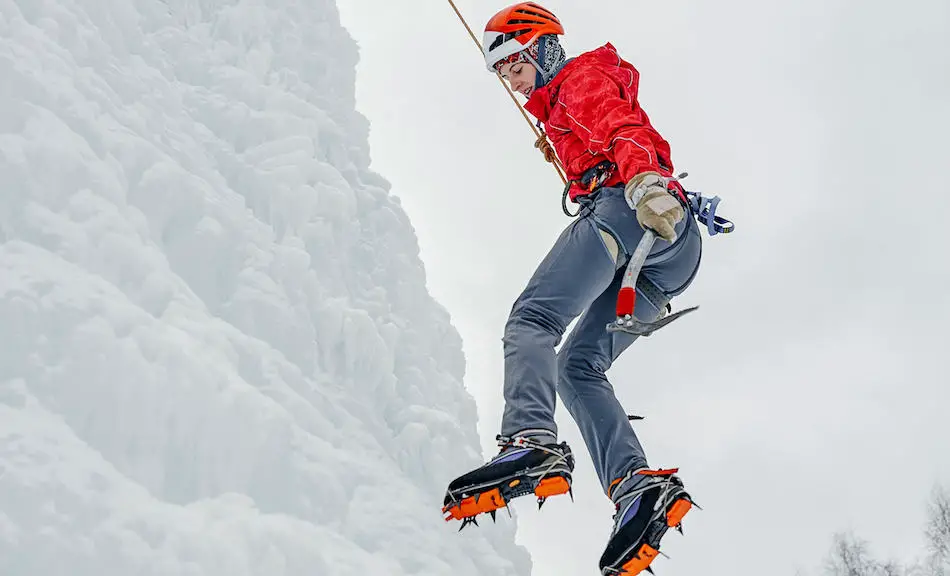
The first time you try on mountaineering boots, you may find it difficult to walk. This is because the boots have extremely stiff rubber along the bottom and sides that keep your foot almost immobile, preventing any flex along the sole. They’re not quite as stiff as a ski boot, but they’re far less flexible than your average hiking boot will be.
These stiff soles allow for ice climbers to comfortably stand while on the wall. Remember, when ice climbing, the only part of your foot that’s actually touching the wall is your crampon point, which will be driven deep into the ice. Because of this, you have to use your calves to keep your foot level. The stiff sole of a mountaineering boos allows for the weigh to better transfer along the bottom of your foot, preventing you from relying entirely on your toes for purchase.
Similarly, the stiff soles keep you in place and prevent any sideways motion. This is important when trying to balance and find surface on the ice.
Mountaineering vs Hiking Boots
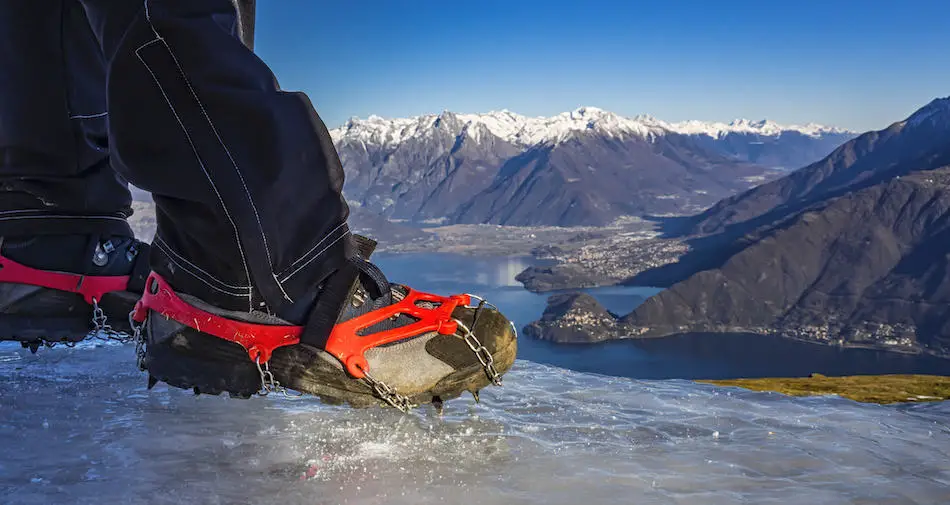
Many people believe that mountaineering boots and hiking boots are similar to each other. They’re made of similar materials, have similar construction, and are manufactured by the same company. Despite this, there are some important differences between the boots.
For starters, hiking boots don’t have a full shank in the sole, which means they’re much more flexible than your traditional mountaineering boot is going to be. This is good if you’re using them for hiking or walking in, as the flex is more comfortable for your foot. Additionally, hiking boots are going to be much more lightweight and breathable. This keeps your feet cool, while also allowing you to conserve more energy; putting extra weight on your foot can sap at your strength faster than almost anything else.
Another difference is the features of the boot, as mentioned above. Hiking boots do not have rubber grooves for holding traditional ice climbing crampons. This doesn’t mean, however, that you can’t use these boots with other types of crampons. Tractions devices, trail crampons, and flexible-binding crampons(like those pictured above) will all be compatible with your hiking shoes.
Despite the fact that you can fit certain types of crampons over them, hiking boots cannot be used for ice climbing. The reason is as follows: the crampons compatible with hiking boots are ones that do not feature ice-climbing specific front points (the part of a crampon that you kick into the ice to gain traction). This means that, while the crampons will be excellent for glacier travel, snowy approaches, or shoulder-season hiking, they cannot be taken on ice climbs.
Mountaineering Boots for Other Activities
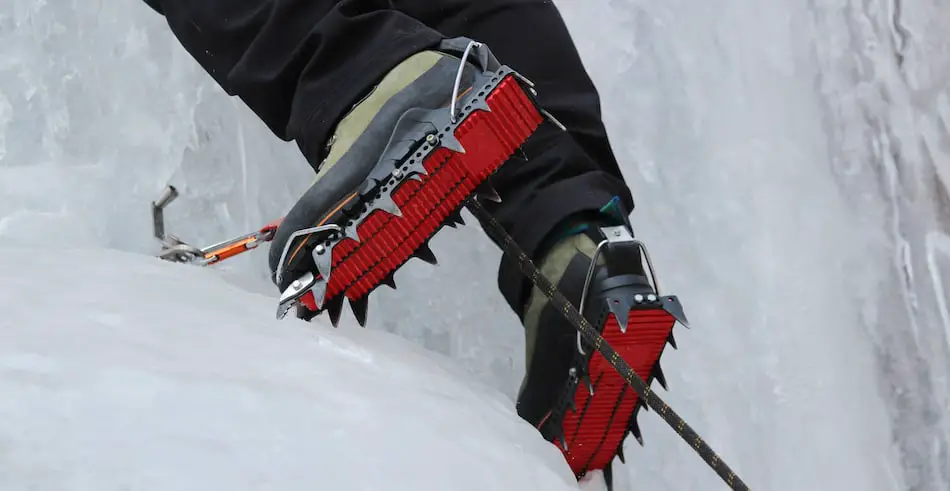
Mountaineering boots cost a lot of money and are a significant investment to make. Because of that, you might want to use them for other activities besides ice climbing. In this next section, I talk more about what you can expect from your boots for a variety of mountain-related activities.
Mountaineering/Alpinism
As is probably fairly obvious, these boots excel in alpine objectives. The high ankle keeps snow out, the soles allow for great traction, and the crampon compatibility helps you on steeper sections. There’s really no other footwear that can be used in alpine environments.
Scrambling
Scrambling is a hybrid activity that blends hiking with low-level rock climbing, normally performed without any ropes worn.
Some people like to use their mountaineering boots when scrambling. The heavy-duty design helps when bushwhacking on approaches, while the stiff soles and firm toes can make your foot placements feel more solid than they would in a pair of hiking boots.
This lack of flexibility, however, can turn into your worst enemy if you’re on a slab route. Because they don’t bend, it’s extremely difficult to make a mountaineering boot stick to a smooth piece of rock. If you’re on a class 3-4 scramble and you know you’ll need to traverse some slabby sections, it might be a good idea to leave the mountaineering boots at home.
Hiking or backpacking
Mountaineering boots will work for hiking in much the same way that a Panzer tank will work for getting your kids to school: sure, it does the job, but it’s complete overkill— and it’s going to murder your gas millage.
If you somehow climb in the high alpine but don’t own a pair of hiking boots, your mountaineering ones will technically work fine for hiking. They have ankle support, good soles, and are durable enough to not get damaged. However, your feet are going to be super hot, your steps will feel clunky, you’ll use a lot of energy, and you’ll do a significant amount of damage to the trail.
Personally, I would leave the mountaineering boots at home in favour of something more lightweight and activity-appropriate.
Skiing or Snowboarding
Mountaineering boots are designed to fit with crampons but not much else. They don’t have the necessary elements to bind with a pair of skis or a snowboard, and therefor won’t be much use for these activities.
Best Mountaineering Boots?
The title of best mountaineering boot is a tricky one to assign. A lot of it comes down to personal preference, foot shape, and what you want your boots for. Companies are constantly coming out with new models, updating old ones, and finding innovative ways to make their boots better. Because of that, it’s really hard to say definitively what the ‘best’ boot is.
In my opinion, the best boot is the one that fits the best. Nothing sucks more than having sore or cold feet after a long day in the mountains, so making sure you have comfortable boots can go a long way to helping you enjoy your ice climbing experience.
There are also different styles of boot that should be considered depending on what activity and climate you’re going to be using them in. Lightweight or single boots might be best for tricky mixed climbing in moderate climates, whereas double boots are probably best for people who need to endure cold and harsh conditions.
Conclusion
So, there we go! That’s my answer for what boot you need to wear ice climbing. All the information provided in this guide is meant to inform, not to instruct or suggest any techniques or best practices. Do your own research and seek professional guidance if there’s anything you’re unsure of before heading into the wilderness.
